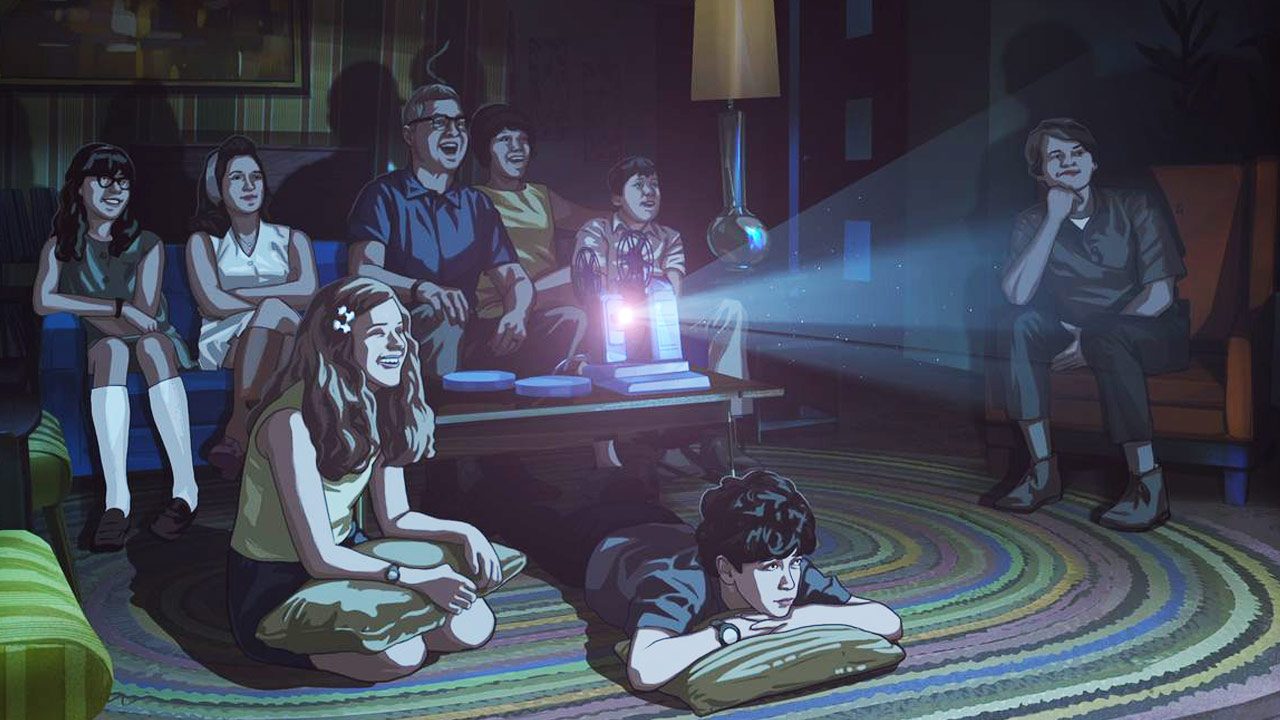Apollo 10½: A Space Age Childhood turns the moon landing into a gorgeous dream

Using a technique that transforms live action into animation, this gorgeous Netflix original is a distinctly personal reflection on the space race, writes Luke Buckmaster.
Richard Linklater’s lovely rumination on the Apollo 11 moon landing is a time capsule, history lesson and fantasy-infused personal journal, constructed using a technique called rotoscoping. This process, which transforms live action footage into animation, is perfect for evoking a state of half reality or waking life. Those latter two words in fact are the title of the director’s first film that utilized it: a freewheeling collection of dreamy vignettes in which outside-the-box thinkers babble philosophical ideas about existence and consciousness.
In Apollo 10½: A Space Age Childhood, the aesthetic is used to illustrate a mutation of history and fantasy: a kind of imagined memory, hinged on the protagonist Stan (voiced by Milo Coy) insisting he was approached by top secret government agents for a special mission to save the moon landing. The space ship they built was accidentally constructed with areas too small for adults to fit into, you see, leading these Very Important People to recruit him for a Very Important Mission, imploring him to help “beat those damn Russians” because “you’re our only hope.”
This sweet faux revisionism—not intended to be taken too seriously—indulges every child’s view of themselves as the most important figure in the universe. Nor is it the point or perspective of the film: this isn’t an adventure in the key of Teen Titans or Spy Kids, which inflate the youngsters’ role and infantilize the viewer.
The film’s backbone isn’t a “child saves the day” narrative but an extensive The Wonder Years or memoir-like narration (wholesomely voiced by Jack Black), presenting a personal essay commentating on socio-political-cultural circumstances surrounding the space race as well the formative experiences of the narrator. These experiences and observations, reportedly inspired by the director’s own upbringing, span various domesticities (i.e. Stan’s house chores and his mother’s cooking) to portraits of other family members and observations of then-contemporary movies and TV shows.
An early image transforms a vision of earth—presented as a round globe seen from outer space—into a ball tossed around in the school yard, symbolizing the broader experience, taking a large historical context and positioning it inside a personal framework. The film works beautifully: a big story with small, lovingly textured details, written self-probingly but without cynicism. Apollo 10 ½ continues two recurring themes in Linklater’s work: time and memory, though the latter often arises not as an intellectual inquiry per se but a natural consequence of the former.

Memories evoked in his beloved Before trilogy, for instance, largely come from anecdotal observation (in the minds of his characters and his audience) rather than the shape and form of the films. The opening scene in Before Sunset contains brief visual flashbacks to events in Before Sunrise, showing Ethan Hawke and Julie Delpy’s prospective lovers hanging out in Paris, though we don’t need this repetition. Linklater mostly trusts us to recall emotions and details ourselves.
The act to recalling memories is more explicit in Apollo 10 ½: through that thick, nostalgia-heavy narration, and also through the very surface of the film. The rotoscoping suits these nostalgic elements because it looks both kind of old and kind of new—encapsulating the past tense of the narration and the present from which it emerges. The protagonist’s seemingly endless reflections, adult Stan commentating on anklebiter Stan’s life and thoughts, embraces a deeply appealing fantasy: of experiencing the body of youth and the wisdom of adulthood.
There are obvious, essential differences between Apollo 10 ½ and director Todd Douglas Miller’s terrific 2019 film Apollo 11—another highly ambitious reflection on the moon landing. Linklater uses extensive narration while Miller uses none. Apollo 10 ½ is a personal narrative, tinged in play revisionism, and Apollo 11 a doco assembled using pre-existing footage. Linklater deployed sound most powerfully for vococentric purposes, while Miller uses a striking score—full of synthesizers and orchestral blasts—as a sort of sonic mind trip, achieving a kind of fiction archival materials cannot.
And yet they make excellent companion pieces, their differences working in concert. Miller captures the awe-inspiring largeness of the space race process while Linklater brings it all back home, reflecting on what values people like him (in this case a white, middle-class American) placed on it; how it stirred the imagination. It’s unlikely we will get another space race movie as good as Apollo 10 ½ for some time—although, truth be told, I felt the same way after watching Apollo 11.


















